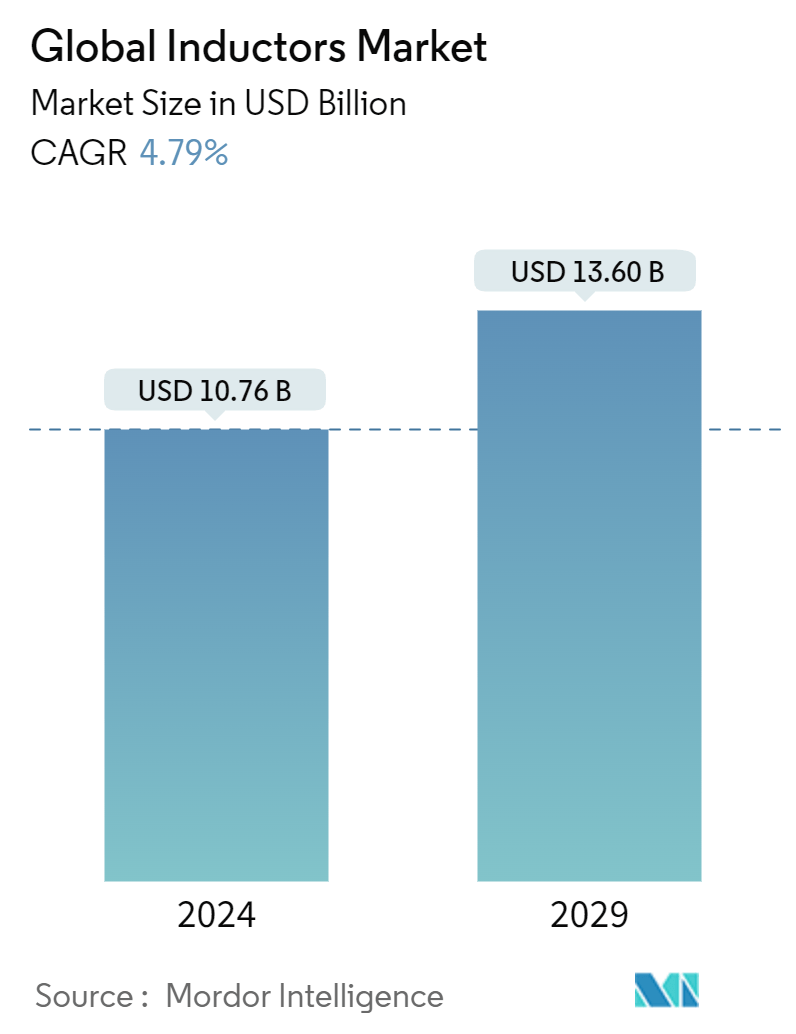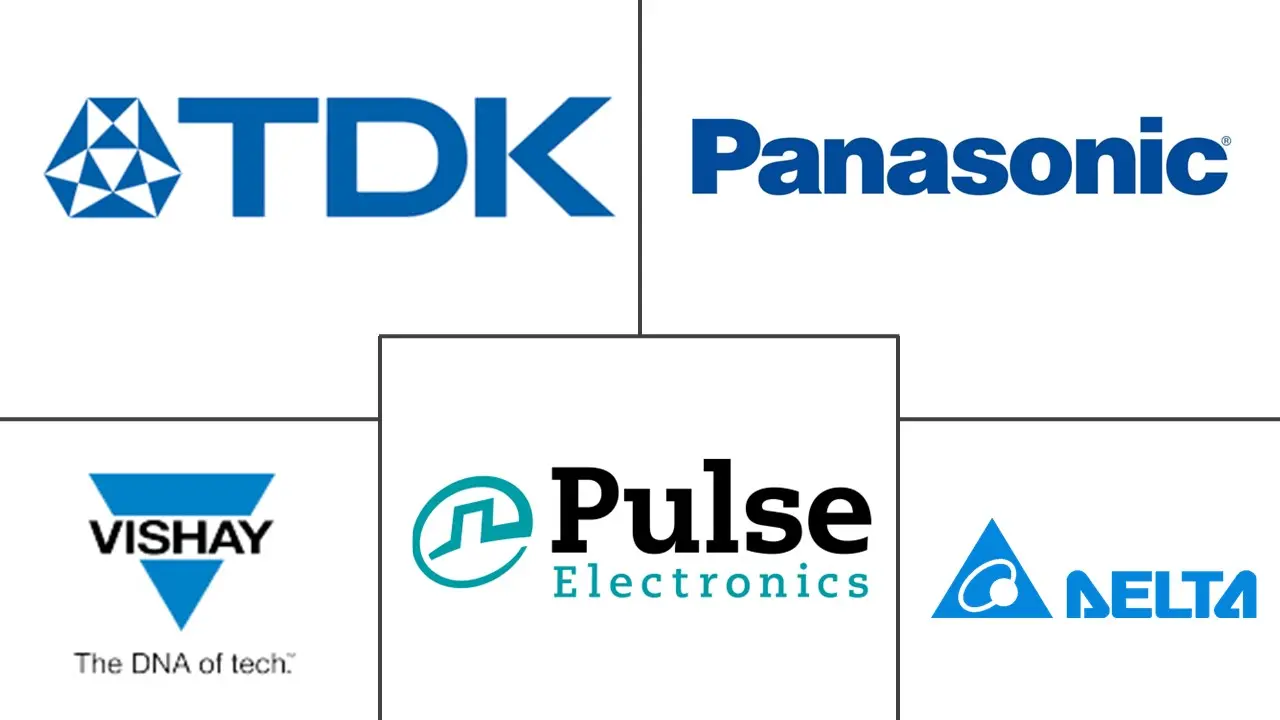Market Size of Global Inductors Industry

| Study Period | 2019 - 2029 |
| Market Size (2024) | USD 10.76 Billion |
| Market Size (2029) | USD 13.60 Billion |
| CAGR (2024 - 2029) | 4.79 % |
| Fastest Growing Market | Asia Pacific |
| Largest Market | Asia Pacific |
| Market Concentration | Low |
Major Players
*Disclaimer: Major Players sorted in no particular order |
Inductor Market Analysis
The Global Inductors Market size is estimated at USD 10.76 billion in 2024, and is expected to reach USD 13.60 billion by 2029, growing at a CAGR of 4.79% during the forecast period (2024-2029).
- With the advent of technological advancements, electronics and electronic devices are getting more complex, primarily due to the increasing consumer demand for small or slim devices. Customers have a specific standard for these devices nowadays, for instance, sleek, thin design, with the screen going from edge to edge.
- Smartphones have witnessed the great success of MEMS gyroscopes owing to their low cost, miniature size, and lightweightness. Features like voice-enabled smart devices have increased adoption over the past few years. The adoption of smart devices, such as the Amazon Echo, Google Home, and Sonos, was aggressive by the end of 2023. The younger generation views these devices as the more innovative, faster, and easier way to perform everyday activities. A recent survey conducted by Accenture revealed that more than 50% of internet users use digital voice assistants globally. This is further expected to add to the complexity of electronics, thereby augmenting the demand for inductors.
- Inductors also play an essential role in the healthcare and medical devices industry. Various advancements in the healthcare sector, including improving macro-sized hospital equipment, medical wearables, and point-of-care devices, are expected to increase the demand. The medical industry is continually driving the need for electronics. As technology enhances and smaller, denser, more reliable boards become possible, passive electronic components will play an increasingly important role in healthcare.
- The use of metals, including coppers, iron, and other ferrite substances, for the core and coil of inductors creates the production dependency of inductors on the raw material price. Fluctuations in the supply chain and raw material costs can increase the lead time and impact the profit margin of the market vendors, hindering market growth.
- The increasing inflation and interest rates further decreased consumer spending, which restricted the market’s growth in 2022 and 2023. Due to the war in Russia and Ukraine, European countries experienced inflation, and compared to January 2022, inflation in Germany, Sweden, France, and the United Kingdom increased significantly. In August 2023, the United Kingdom’s inflation rate was 6.7% compared to 5.5% in January 2022. These factors hampered the market’s growth in 2023. According to the Bureau of Labor Statistics, the US manufacturing sector’s output reduced by 0.1% in the third quarter of 2023. This may lead to decreased demand for inductors from the manufacturing sector.
Inductor Industry Segmentation
Inductors are passive two-terminal electrical components that store energy in a magnetic field when electric current flows through them. Most power electronic circuits include inductors, which are passive elements that store energy in the form of magnetic energy when electricity is supplied to them. A significant characteristic of an inductor is that it resists changes in the amount of current that passes through it. To equalize the current flowing through it, whenever the current across the inductor varies, it either gains or loses charge.
The inductor market is segmented by type (power and frequency), core (air/ceramic core, ferrite core, and other cores), end-user vertical (automotive, aerospace & defense, communications, consumer electronics & computing, and other end-user verticals), and geography (North America, Europe, Asia-Pacific, and Rest of the World). The market sizes and forecasts are provided in terms of value (USD) for all the above segments.
| By Type | |
| Power | |
| Frequency |
| By Core | |
| Air/Ceramic Core | |
| Ferrite Core | |
| Other Cores |
| By End-user Vertical | |
| Automotive | |
| Aerospace and Defense | |
| Communications | |
| Consumer Electronics and Computing | |
| Other End-user Verticals |
| By Geography*** | |
| North America | |
| Europe | |
| Asia | |
| Australia and New Zealand | |
| Latin America | |
| Middle East and Africa |
Global Inductors Market Size Summary
The global inductor market is poised for steady growth, driven by the increasing complexity of electronics and the demand for smaller, more efficient devices. As consumer preferences shift towards sleek and compact designs, the need for inductors in various applications, including smartphones, smart home devices, and healthcare equipment, is expected to rise. The market is also witnessing a surge in demand due to the proliferation of 5G technology and the subsequent need for RF inductors in communication devices. The Asia-Pacific region, particularly countries like China, Japan, and South Korea, is a significant contributor to this growth, fueled by advancements in the semiconductor industry and the rapid adoption of 5G networks. The automotive sector's expansion further propels the demand for inductors, especially in power conversion models and infotainment systems.
Despite the promising growth trajectory, the inductor market faces challenges such as fluctuations in raw material prices and supply chain disruptions, which can impact production costs and profit margins. Economic factors like inflation and rising interest rates have also posed challenges, particularly in Europe and the United States, affecting consumer spending and manufacturing output. However, major players in the market, including TDK Corporation, Vishay Intertechnology Inc., and Panasonic Corporation, are actively engaging in strategic partnerships and product innovations to maintain a competitive edge. The market remains fragmented, with both global and regional players vying for market share, and ongoing developments in electric vehicle power electronics and high-frequency circuits are expected to shape the industry's future landscape.
Global Inductors Market Size - Table of Contents
-
1. MARKET INSIGHTS
-
1.1 Market Overview
-
1.2 Industry Attractiveness - Porter's Five Forces Analysis
-
1.2.1 Bargaining Power of Suppliers
-
1.2.2 Bargaining Power of Buyers
-
1.2.3 Threat of New Entrants
-
1.2.4 Threat of Substitutes
-
1.2.5 Degree of Competition
-
-
1.3 Industry Value Chain Analysis
-
1.4 Impact of Macroeconomic Trends in the Market
-
-
2. MARKET SEGMENTATION
-
2.1 By Type
-
2.1.1 Power
-
2.1.2 Frequency
-
-
2.2 By Core
-
2.2.1 Air/Ceramic Core
-
2.2.2 Ferrite Core
-
2.2.3 Other Cores
-
-
2.3 By End-user Vertical
-
2.3.1 Automotive
-
2.3.2 Aerospace and Defense
-
2.3.3 Communications
-
2.3.4 Consumer Electronics and Computing
-
2.3.5 Other End-user Verticals
-
-
2.4 By Geography***
-
2.4.1 North America
-
2.4.2 Europe
-
2.4.3 Asia
-
2.4.4 Australia and New Zealand
-
2.4.5 Latin America
-
2.4.6 Middle East and Africa
-
-
Global Inductors Market Size FAQs
How big is the Global Inductors Market?
The Global Inductors Market size is expected to reach USD 10.76 billion in 2024 and grow at a CAGR of 4.79% to reach USD 13.60 billion by 2029.
What is the current Global Inductors Market size?
In 2024, the Global Inductors Market size is expected to reach USD 10.76 billion.

